#One Trade Africa
Text
Relancer le commerce intra-africain pour renforcer la reprise post-Covid-19 et favoriser la sécurité alimentaire.
Relancer le commerce intra-africain pour renforcer la reprise post-Covid-19 et favoriser la sécurité alimentaire.
Le programme « One Trade Africa » du Centre du commerce international aide les MPME africaines à tirer parti des opportunités du marché
La pandémie de Covid-19 compromet la trajectoire de développement de l’Afrique. Elle prélève un lourd tribut socio-économique et met en danger la survie de la moitié des Micros, petites et moyennes entreprises (MPME) du continent. Quatre entreprises africaines…
View On WordPress
0 notes
Text
I totally understand that having 3 races in 1 country seems excessive, and I definitely think that if they want as many races in the US as they do, F1 should at least do cool tracks (like Indianapolis) but I wanna point something out
the distance between Hungary to Spa to Zandvoort is 1,526km
in comparison Miami to Austin to Las Vegas is 4,247km
if I lived in Hungary, it would be faster for me to get to the Belgium Grand Prix than it is for me, a Floridian, to get to the Austin Grand Prix
If F1 wants to grow their fan base in America, it needs to make it accessible (which, even though we have 3, it still fucking isn't). There are definitely problems with the US races but I don't think the amount is one of them.
#im willing to trade miami and las vegas#if europeans are willings to trade 3 of their 9 races#put one in south africa maybe#another one in south america#have at least one on each continent#formula 1#f1#formula one#las vegas grand prix#united states#motorsport
12 notes
·
View notes
Text
i genuinely don't understand what capitalist countries stand to gain by fighting each other instead of collaborating economically. like why does the us warmonger against china when we would benefit more from trade? ostensibly it's for moral reasons, but regardless of the veracity of any given claim i think the united states has shown itself to prioritize economic success over human rights on a number of occasions especially during the cold war. i suppose i assume most wars are waged on the grounds of economic gain (natural resources, global political power, straight up money in the form of the military-industrial complex) but you could make an equally solid argument that just as many are waged over purely social and political issues- ethnic and religious conflict, blind nationalism, the whims of a dictator. it just confuses me at times, i guess. i have a hard time believing that the united states is bound and determined to wage war against china over human rights abuses, infringing on other countries sovereignty, and neo-colonialism in africa when we've propped up fascist dictators in many a country who've done far worse. is it literally just the association with communism? because surely whatever evil fuckers actually want war know that china is very far from communist right now. is it just nationalism? the idea that we must be on the top of the totem pole, even if our economy would stand to gain from trade? because i suppose i could believe that, but i think if that was true we wouldn't have gotten to where we are today in the first place. blegh. at the end of the day i am also ignoring the fact that many many different groups of people want war against china for reasons ranging from sinophobic jingoist nationalism to a genuine belief that the united states is a global moral watchdog determined to establish ~democracy~ worldwide. but there is a definite slant to media coverage on china right now, genuine attempts at disinformation, and given that the media in the us is so deeply tied to corporate interests it leads me to believe that there has to be some economic motive here, and it frustrates me that i can't figure out what it is.
#this post is long and convoluted and circuitous. sorry.#please do not try to like. publically own me or erupt into moral outrage over this post if you're reading it btw.#suppose i would be interested in hearing others takes on this but im just curious i genuinely don't have answers here#i don't want to argue or be accused of being immoral for not taking a hard stance on an incredibly complex issue.#anyway. i am also not trying to say that either the us or china are ' good ' or ' bad '#insomuch as any country can be good or bad. particularly a country millenia old or one that changes leadership every four years.#individual actions taken by each government are undeniably bad. yes.#but as a us citizen i find it very difficult to find reliable information about what is happening in other countries.#our media has become so wildly polarized that you can often figure out national issues by looking at both sides#but when the media is unified on portraying one falsehood both left and right? you're fucked.#often media that claims to be neutral could be more accurately described as western#i trust ap and the bbc on us politics - not global politics.#all that being said when it comes to things like the treatment of uighur muslims or the political situation in hong kong and taiwan.#i'm not entirely sure what to believe.#and i also believe that if every single immoral act the us claims china has done is real... we still wouldn't wage war based purely on that#...i do genuinely think the claims that china is colonizing africa by offering loans is horseshit though#even if it was itd be fucking rich for european countries that wrecked africa in the first place#to moralize about the means by which another global power allows them potential economic power#the problem arises from capitalism on a global scale itself i mean#there is no way to build up infrastructure and trade routes for an entire continent without#in some way eventually profiting from it#i do see the comparison to the us and latin america and i think that's kinda apt but#the way ppl talk about it you'd think they were doing what france did to haiti good god
4 notes
·
View notes
Text
i'll tell you one thing that absolutely threw me and that i will be laughing about all week. i turned to tiffany cross' show and she was interviewing this african historian about the new woman king movie and she had asked him about the dahomey tribe's role in the transatlantic slave trade, but toward the end of the segment she asked if african tribes involved in the slave trade should have to pay reparations to black americans (and the rest of the diaspora i guess). and WHEW. LMFAO i know she was just asking a question related to what she has seen in the discourse online but bro LMFAO. oh my God. can you imagine if people were seriously arguing that any random group of africans on the continent should have to pay money en masse to americans. whew boy
#the social significance of tribes in the africa of 200-500 years ago obviously is not the same now#but slavery is one of the world's oldest institutions and it existed in africa for a very long time#this idea that there is an 'us' and a 'them' when it comes to the slave trade is crazy#they were all africans lol...the home countries of enslaved people also suffered from the slave trade AND africans were enslaved in europe#and inside the continent on colonial plantations and the like#many people were sold to european traders by members of their own tribes#and slavery could also be punishment for a crime or other social transgression#and just because someone was given or sold to europeans doesn't mean the people doing the selling had any idea what fate awaited them#but also. yeah this is the problem with being obsessed with african royalty and elite in the pre-modern period#all royals are royals at the expense of others lol.........we know slaves built egypt but y'all worship the pharaohs anyway.#mansa musa had slaves but y'all worship him anyway#whew Lord that is going to give me comedic material for days. yeah i'm waiting on my check from some mf in angola RIGHT NOW...tick tock!#honestly if you want reparations from africa you'll have to get them from europe and the us anyway#how about we call it even after liberia huh#God can you imagine how insane you have to be to really be suggesting that like on a serious level. whew
18 notes
·
View notes
Text
Whenever I hear other African Americans say they're not black but indigenous/aboriginal a part of me dies
#like you can't be pro black but then ashamed to call yourself#majority of african americans are descendants of slaves and that's ok#we don't all have to come from royal blood and we also don't have to be native to america#there is history books on the slave trade and how west africa was colonized#there is a difference from having the theory that black people were one of the first humans to exist and traveled to countries#which created the blue eye gene or light skin#but claiming to be native american or aboriginal when it's not in your dna or you're even a direct descendant of its just not accurate#because then that creates another issue where people are erasing another ethnic group#not to mention wearing regalia or items from just any tribe you can find is considered cultural appropriation#also there were native american tribes who enslaved black people so the logic just doesn't make sense#non blacks dni
0 notes
Text
As it apparently needs to be restated - race, ethnicity, and nationality are not themselves the basic drivers of history. Political-economic class is.
The European practice of placing African people into chattel slavery was not carried out on the basis of any innate characteristics of 'blackness' or 'whiteness' - those categories did not exist before the slave trade, they were created in support of it. Europe at the time found it would be beneficial to have a class of slave workers for its colonial projects, and it had the military, political, and economic might to subjugate Africa and African people to that end. Had you asked a Prussian and a Scotsman prior to the institution of African slavery if they were both members of a common 'race', they would have found the idea ridiculous - and yet, transport those two ahead in time, and perhaps to settlements in the Americas, and suddenly they were both Whites. Whiteness (and its necessary counterpart, blackness), then, is not some intrinsic quality based on the tone of someone's skin, but a political and economic category constructed to differentiate between those people that could be oppressed and made chattel by the slave trade, and those that could not.
This is true for all these systems of oppression - though they may be divided on supposed lines of biology or locality, they are not inherently based on biological factors, those are functionally coincidental, and are constructed as justifications for a system necessitated by purely political and economic reasons. Nazi oppression of Jewish, and Roma, and Slavic [and etc.] people was not fundamentally based on any inherent quality of e.g. Judaism, but on the economic needs of German capital under the burden of postwar reconstruction and 'war reparations' paid to the victorious powers. It was not blind hatred, but the inevitable result of a society built in pursuit of profit - one whose ruling class held a cold, calculated need to expropriate wealth, weaken worker organisation, and seize and depopulate land to strengthen the composition of capital. It was still necessary for this system to split the population into one group of 'legitimate targets' for victimisation, and one of reassured, protected accomplices, though there were no obvious physical, 'biological' features to base these on - so they were constructed, both through propaganda that exaggerated physiology, and through the appending of obvious badges and marks onto those targeted. Again, these were sets of features, and categories, created to support a system of oppression and exploitation, not the reasons it came into being in the first place.
Again, these are fundamentally political and economic categories, and can only be properly understood as such. If not properly understood as being based, first and foremost, on material interests of classes, then any analysis of them is unstable. For example: appeals to the supposed ancestral claim of zionists to the land of Palestine, and thereby to indigineity, can only be refuted with an understanding that indigeneity is a political and economic characteristic, of relation towards the oppression of a settler state, and not some characteristic of where one's ancestors were born. None of this is to say that race, nationality, etc don't function as axes of oppression - but that they must be understood as manifestations of the existing political and economic material interests of classes that drive the development of history, if they are to be fought against.
3K notes
·
View notes
Text
“Many guilty consciences have been created by the slave trade. Europeans know that they carried on the slave trade, and Africans are aware that the trade would have been impossible if certain Africans did not cooperate with slave ships. To ease their guilty consciences, Europeans try to throw the major responsibility for the slave trade on to the Africans. One major author on the slave trade (appropriately titled Sins of Our Fathers) explained how many white people urged him to state that the trade was the responsibility of African chiefs, and that Europeans merely turned up to buy captives- as though without European demand there would have been captives sitting on the beach by the millions! Issues such as those are not the principal concern of this study, but they can be correctly approached only after understanding that Europe became the center of a world-wide system and that it was European capitalism which set slavery and the Atlantic slave trade in motion.”
― Walter Rodney, How Europe Underdeveloped Africa
280 notes
·
View notes
Text
The near future in the Doctor Who universe sure gets dire doesn't it? Especially if Mad Jack / Roger ap Gwilliam is still part of history.
I thought I'd have a bit of fun listing things out, combining as many sources as possible. Turns out he fits in shockingly well with what we know. There's a lot missing here or cut out, and for obvious reasons it's very UK / Europe focused, but nonetheless:

[ID: Scene from The Christmas Invasion showing Harriet Jones on BBC News. The news ticker reads "PM HEALTH SCARE", "Unfit for duty?", and references a "SECRET GOVERNMENT MOLE" and a quote: "BLOOD ON [HER HANDS]".]
2006-2021 (obviously the past now, but still noting for the resulting temporal and political butterfly effect) - In the original timeline, Harriet Jones remains Prime Minister for 3 consecutive terms, presumably 15 years assuming no snap election was called, referred to as a 'golden age' [World War Three]. The Tenth Doctor deliberately changes history to cause her deposal [The Christmas Invasion], leading to numerous disastrous terms in the meantime, including those of Harold Saxon [The Sound of Drums et al.], Brian Green (who tried to appease the 456) [Children of Earth], Boris Johnson (an auton host of the Nestene Consciousness) [Rose (novelisation)], and Jo Patterson (responsible for deploying cloned Dalek defence drones in the UK's streets) [Revolution of the Daleks].

[ID: Scene from Revolution of the Daleks. A 'defence drone' Dalek is used to support anti-riot police in a test, dispersing protestors with mock tear gas.]
2010s-2030s - The European Union gradually integrates further, eventually becoming the European Zone / Eurozone, a global superpower which competes with the USA through the 21st century. The UK eventually forms part of the bloc [Trading Futures].
It's likely that Harriet Jones's deposal led to this and related events being delayed or erased, with Brexit (driven by, among others, one of Jones's successors in the new timeline) reducing european unity. Most notably, Ramón Salamander's rise to power occurs now not in the 2010s [The Enemy of the World], but in the 2030s [Doctor Who and the Enemy of the World]. There are other events that are seemingly delayed by ~20 years by changes to the timeline, including future events like the dictatorship of Mariah Learman [The Time of the Daleks, Trading Futures], and yet also possibly past events like the death of Queen Elizabeth II [Battlefield, The Longest Night et al.], which may suggest something else (eg. the Time War) may be responsible.
~2030 - During a time of rising global tensions [73 Yards], Ramón Salamander convinces a group of scientists in an underground shelter endurance experiment that nuclear war has broken out on the surface. They are convinced to generate artificial "natural" disasters to fight back against the enemy. Between this and ongoing climate change, several global food sources collapse as a result, including Canada and Ukraine's corn and flour production [The Enemy of the World].
2031 - Tensions culminate in the "Great Russian War". Despite posturing, not a single nuclear weapon is fired, at least by NATO [73 Yards]. This may be later considered World War III [Trading Futures].
~2032-2035 - Following the war, tensions rise again, now between the Eurozone and the USA [Trading Futures], possibly in reaction to actions (or lack thereof?) taken by NATO during the war [73 Yards]. Both send separate peacekeeping forces to conflict in North Africa. Meanwhile, Italy is engaged in civil war [Trading Futures].
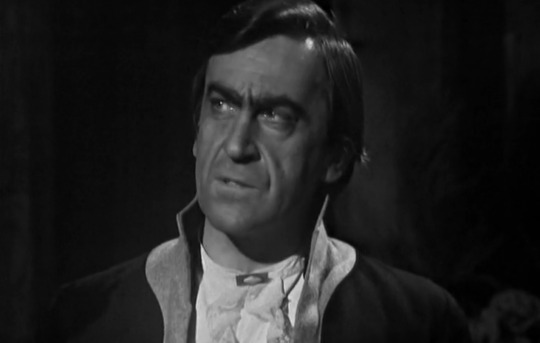
[ID: Scene from The Enemy of the World, showing Ramón Salamander.]
Over the decade, Ramón Salamander rises in power in the World Zone Authority, using his patented "Sun Store" satellite technology to aid the growth of crops by controlling sunlight over agricultural regions. In the background, he murders and blackmails officials to place loyalists into powerful positions, with the goal of ruling over the World Zone Authority as a dictator. Salamander's treachery is later discovered and he disappears [The Enemy of the World].
2037 - 2042 - Several militia declare wars of Independence from the USA. Notably, Phoenix, Arizona is destroyed in a terrorist attack. While the country largely persists after the conflicts, some territories seem to successfully secede - with, for example, a Montana Republic seemingly being in existence in 2054 [Alien Bodies].
2038 - The World Zones Accord is signed. This is later considered to have reduced the United Nations to a 'joke' compared with the World Zone Authority [Alien Bodies]. Given the extensive power it gives to the WZA, this was likely originally part of Salamander's plan, but due to his disappearance he is not around to reap the rewards [The Enemy of the World].
2039 - A group of Mexican astronauts studying minerals on the Moon go missing [Kill the Moon].
~2030s - 2040s - The Earth begins to experience major climate change effects, including "appalling storm conditions" which harm agriculture [The Waters of Mars]. The ice caps melt and flood much of the Earth [K9] with nations like the Netherlands ending up entirely flooded [St Anthony's Fire]. Some regions experience corrosive acid rain [Cat's Cradle: War Head, Strange Loops]. One summer sees Britain experience a 22 week drought. At this time, the Eurozone closes its borders to millions of North African and Baltic Sea refugees [Hothouse]. This time period may be known as the "Oil Apocalypse" [The Waters of Mars].

[ID: Scene from K9 Episode 13: Aeolian. Big Ben stands in the middle of a colossal storm of wind and rain.]
With Earth's ecosystems collapsing [Davros], humanity begin to realise it's facing extinction [The Waters of Mars]. An artificial cooling agent is spread in the atmosphere to semi-successfully combat the effects, but leads to dramatic side-effects, including freezing some areas of the globe. This is known as the "Great Cataclysm" [K9].
2041 - A three-human team, including Adelaide Brooke, lands on Mars for the first time [The Waters of Mars]. However, with this accomplishment, and increasing turbulence on Earth, Humanity gradually loses interest in space exploration [Kill the Moon].
Before 2045 - Around this time, the UK falls into a dictatorship ruled by the "Director", head of a military council that has allegedly (secretly?) controlled the government since 2028 [Britain Protests]. It is possible that this Director was previously the "Minister of War" for previous governments [Before the Flood].
2045 - The World Zones Authority evolves into a World Government, with Nikita Bandranaik being elected President. The UK is not part of the organisation [This is 2065].
2046-2050s - The Director is overthrown [Down with the Director] and the rest of the government "collapses in shame" [73 Yards]. Some of the revolutionaries celebrate now being "masters of [their] own country" [Down with the Director]. Despite the hopes of the World Government for international integration, this nationalistic streak continues.

[ID: Scene from 73 Yards. Roger ap Gwilliam, with an Albion Party ribbon on his chest declares victory on BBC News, live from Kennington High in London. Headline reads "LANDSLIDE VICTORY FOR ALBION PARTY: Majority of 92 predicted. Roger ap Gwilliam declared Prime Minister."]
Roger ap Gwilliam is elected Prime Minister, with the far-right nationalistic Albion Party gaining a majority of 92 MPs [73 Yards]. While his government does take the step to officially join the World Government senate [Down with the Director], he seeks greater independence from other nations. One of his first actions is to expand the UK's nuclear arsenal, purchasing missiles from Pakistan and withdrawing from NATO. In his term, the world is brought to the brink of nuclear war [73 Yards], likely in the pre-2050s "Euro Wars" [The Time of the Daleks].
In this time, the "Department", a (private?) multinational security organisation is born, based primarily in the UK. They gain broad powers, which they use to control populations with propaganda and use of "CCPC"s: robotic law enforcement notorious for their surveillance and brutality. Despite its recent revolution, the country is rendered practically a police state [K9].

[ID: Scene from K9 Episode 1: Regeneration. CCPCs, hulking police robots, march down a dark alley.]
2049 - The Moon starts to dramatically gain mass, causing massive tides on the Earth, flooding entire cities. In a last ditch at survival, humanity plans to try and destroy the Moon using an array of nuclear bombs. Despite the people of Earth being offered the vote on what to do by turning off their lights, it appears the decision is made on a national level, with lights going off grid-by-grid. Nonetheless, the Moon is allowed to hatch, leaving behind a new less massive egg "moon" with minimal further destruction [Kill the Moon].

[ID: Scene from Kill the Moon. The Moon hatches in the background, as the TARDIS stands by the sea.]
Humanity's interest in space exploration returns [Kill the Moon], starting a new space race. Among these projects, Australia begins constucting a space elevator, Spain a project called "SpaceLink", while Germany and Russia each begin a series of new Moon missions. The Philippines are rumoured to be planning their own landing on Mars [The Waters of Mars].
~2050 - The UK Government (ap Gwilliam's?) is couped once more, by General Mariah Learman. With the King's permission, elections are suspended for at least a couple years, with her ruling over a "benevolent dictatorship". She is later abducted and forcibly mutated by the Daleks [The Time of the Daleks]. Despite the previous description, her promotion of Shakespeare in schools is remembered as the only good thing about her rule [Trading Futures]. (Note: As mentioned prior, it's likely that Learman's rule may have been delayed as Salamander's was. This is suggested by the mention of her in Trading Futures, set seemingly ~2030s or earlier, despite The Time of the Daleks taking place around the 2050s.)
~2050s - The Gravitron is built on the new Moon. This is used to artificially control the tides and weather [The Moonbase]. It likely also is intended to study and monitor the new Moon for future changes [Kill the Moon].
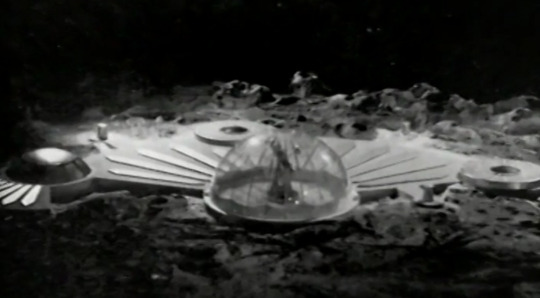
[ID: Scene from The Moonbase, giving an external shot of the base.]
2058 - 2059 - Bowie Base One is established: humanity's first colony on another planet and an international collaboration between the UK, USA, Russia, Germany, Turkey, South Korea, Lithuania, Australia, and Pakistan. One year later, it is mysteriously destroyed in a deliberately triggered nuclear explosion. In the original timeline, there were no survivors. However, after the interference of the Time Lord Victorious, the true story is eventually told on Earth. Regardless "a veil of darkness" sweeps over the planet over the next few years. [The Waters of Mars], as international tensions heat up once more... [Total Eclipse of the Heart].

[ID: Scene from The Waters of Mars, showing an internet news website. Various articles appear focused on the Bowie Base One incident, including "SURVIVORS STORY - BROOKE SAVED EARTH", "THE MYTHICAL DOCTOR", "BROOKE'S HEROIC ACTIONS SAVE EARTH", and "HOW THE COUPLE ESCAPED MARS". The feature image shows the two survivors: Yuri Kerenski and Mia Bennett.]
2060s - The "Great War" breaks out on Earth, involving every country on Earth. This is likely World War IV. Details are vague, but it ultimately ends in a ceasefire, when it's realised the conflict is risking Earth's habitability [Total Eclipse of the Heart].
182 notes
·
View notes
Text


[ID: A greenish-brown soup with an herb garnish in a bowl surrounded by a halved lemon, green cardamom pods, and bay leaves, followed by a close-up of the same soup. End ID]
شوربة الفريكة / Shorabat al-frika (Green wheat soup)
Frika (فَرِيكَة or فَرِيك; also transliterated "freekeh," "frikeh," or "farik") is durum wheat harvested in the early spring, while the grain is green, unripe, and tender. Durum wheat, or semolina, is a different species of wheat than that which is ground to produce all-purpose flour (common wheat, or bread wheat); it is used to make couscous (كُسْكُس), bulghur (بلغور), and many types of pasta, and is widely consumed in North Africa, the Levant, and the Arabian peninsula. After harvest, unripe durum is sun-dried and then set ablaze in piles to burn off the straw and leave just the heads of wheat, resulting in a nutty, smoky flavor; the heads are then vigorously rubbed, traditionally by hand, to remove the bran. Frika is named after this last process; the word comes from the verb "فَرَكَ" "faraka," "to rub."
A staple in Palestine, shorabat al-frika (with diacritics, Levantine pronunciation: شُورَبَة الفْرِيكَة) is often eaten as an appetizer with the fast-breaking meal during Ramadan. It may contain nothing more than an onion, olive oil, frika, and water, but sometimes contains meat (usually chicken, but also beef or lamb), green chili peppers, and spices including cardamom, black pepper, bay leaves, turmeric, cumin, and seb'a baharat; some people today like to add chickpeas. Shorabat al-frika is often prepared with the chicken broth obtained by boiling chicken to make musakhkhan (مُسَخَّن), and served alongside it. It is a warming, filling, and earthy soup, with a complexity of flavor imparted by the frika itself: a fresh tartness due to the unripe grain, and a roasted aroma due to its harvesting process.
Shorabat al-frika is in keeping with a Palestinian food ethos of using simple, local ingredients to their fullest potential. Frika itself is sometimes thought to symbolize adaptability and resilience, as it was often eaten in times of scarcity when other crops were not yet ready to be harvested. Legend holds that it was discovered in a time of similar necessity: when villagers in the eastern Mediterannean tried to salvage a field of wheat that had been burned by ambushing soldiers, they found that the grain was still edible beneath the blackened chaff, having been saved from the fire by its moisture.
Frika, due to its centuries as a staple in Palestine, has also come to symbolize acceptance, Palestinian history, and connection to the land and community. In the Palestinian diaspora and amongst internally displaced people in Palestine, food is conceived of as a form of connection to homeland across distance; continuing to make Palestinian food, and remembering or using baladi ("native," "from my country") varieties of grains, produce, and herbs, is a link to the land and an expression of the hope to return.
By the same token, though, frika has come to represent Palestinian displacement and "cultural obliteration," per Rana Abdulla. One of the ways in which Israel rhetorically justifies its existence is by claiming sole ownership of an old, organically arising culture rooted in the land: the easiest way to do this is, of course, to rebrand what was already there. Food connects and combines language (in terminology and pronunciation), culture, history, climate, and land into one web of discourses, and is therefore a prime site for colonial myth-making and ideological nation-building. Thus a construction such as "Israeli freekeh" is, in fact, an intensely political one.
Nevertheless, frika continues its life as a symbol of connection, community, and resistance during adversity in Palestine. Nasser Abufarha, of the Palestine Fair Trade Association, noted in 2015 that more and more Palestinians across the West Bank were harvesting some of their wheat early to make frika, rather than relying on cheaper, imported rice. As of October 23 2023, and in defiance of an Israeli air raid which destroyed their kitchen in 2014, Jamil Abu Assi and his cousins were using frika, alongside lentils and rice, as staples in distributing food to thousands of refugees per day in Bani Suhaila, near Khan Younis. Others in the community donated ingredients or volunteered to distribute meals.
Support Palestinian resistance by contributing to Palestine Action's bail fund or to Palestine Legal's defence fund, or by attending court or making a sign to support the Elbit Eight.
Ingredients:
1 cup (170g) frika baladia (فريكة بلدية), Levantine frika
4 cups water, or vegetarian chicken stock from concentrate
1 large yellow onion, chopped
1/4 cup extra virgin olive oil
1 green chili pepper (فلفل أخضر حار), sliced (optional)
1/2 tsp ground black pepper (فلفل اسود)
5 cardamom pods (حب هال)
2 Mediterannean bay leaves (ورق غار)
250g chicken (or beef) substitute, torn or cubed (optional)
Salt, to taste
Parsley, to garnish
Halved lemon, to serve (optional)
I have kept the spices relatively simple, as most cooks do, to highlight the earthy end of the taste spectrum and to allow the flavor of the frika itself to come forward. Most people add at least cardamom and black pepper; many add bay leaves to this duo; turmeric is the next most common addition I have come across. I have seen a few people add cumin, coriander, or allspice.
Frika can be found in the grains section of your local halal grocery store (labelled "فريكة", “فريك" "freekeh" or "frikeh"). Look for something that specifies “roasted.”
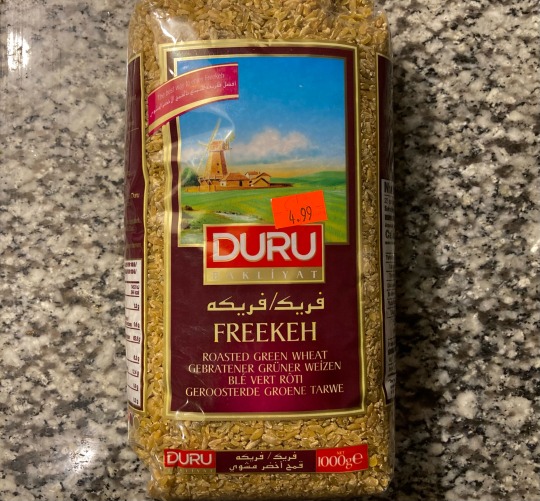
You may also be able to find frika at a speciality or health foods grocery store, but it might not have been fire-roasted as it is in the Levant. If your frika doesn't smell toasty, try roasting it in a dry pan on medium-heat for a few minutes until fragrant.
Frika may be found whole, cracked, or fine (نَاعِمَة / na'ima). You may use any kind for this soup; most people use cracked or fine frika, because of its shorter cooking time. You can pulse whole frika a few times in a food processor or spice mill, until coarsely ground, if you prefer a fine texture but can't find fine frika.

Instructions:
1. Heat olive oil in a large pot on medium. Add onion, a pinch of salt, cardamom pods, and bay leaves and fry, stirring occasionally, until the onion is golden brown.
2. Add the chili pepper and cook briefly until softened.
3. Add frika and black pepper and roast, stirring occasionally, for a few minutes until fragrant.
4. Add the water or stock and stir to combine. Bring to a fast simmer and cook, covered, about 50 minutes for whole frika and 20 minutes for ground, until fully cooked. Add additional water as necessary. The frika will still be chewy at the end of the cooking time.
5. Fry meat substitute of your choice in olive oil with salt, black pepper, and a optionally a pinch of Palestinian seven-spice, until browned. Add to soup and stir to combine. Taste the soup and add salt and more black pepper, if necessary.
6. Garnish with whole or chopped parsley and serve warm.
The meat is usually added to this soup just after the onions, and simmered along with the frika. You can do it this way if you like, but I have never found simmering to do the texture of meat substitutes any favors.

492 notes
·
View notes
Text
An innovation that propelled Britain to become the world’s leading iron exporter during the Industrial Revolution was appropriated from an 18th-century Jamaican foundry, historical records suggest.
The Cort process, which allowed wrought iron to be mass-produced from scrap iron for the first time, has long been attributed to the British financier turned ironmaster Henry Cort. It helped launch Britain as an economic superpower and transformed the face of the country with “iron palaces”, including Crystal Palace, Kew Gardens’ Temperate House and the arches at St Pancras train station.
Now, an analysis of correspondence, shipping records and contemporary newspaper reports reveals the innovation was first developed by 76 black Jamaican metallurgists at an ironworks near Morant Bay, Jamaica. Many of these metalworkers were enslaved people trafficked from west and central Africa, which had thriving iron-working industries at the time.
Dr Jenny Bulstrode, a lecturer in history of science and technology at University College London (UCL) and author of the paper, said: “This innovation kicks off Britain as a major iron producer and … was one of the most important innovations in the making of the modern world.”
The technique was patented by Cort in the 1780s and he is widely credited as the inventor, with the Times lauding him as “father of the iron trade” after his death. The latest research presents a different narrative, suggesting Cort shipped his machinery – and the fully fledged innovation – to Portsmouth from a Jamaican foundry that was forcibly shut down.
[...]
The paper, published in the journal History and Technology, traces how Cort learned of the Jamaican ironworks from a visiting cousin, a West Indies ship’s master who regularly transported “prizes” – vessels, cargo and equipment seized through military action – from Jamaica to England. Just months later, the British government placed Jamaica under military law and ordered the ironworks to be destroyed, claiming it could be used by rebels to convert scrap metal into weapons to overthrow colonial rule.
“The story here is Britain closing down, through military force, competition,” said Bulstrode.
The machinery was acquired by Cort and shipped to Portsmouth, where he patented the innovation. Five years later, Cort was discovered to have embezzled vast sums from navy wages and the patents were confiscated and made public, allowing widespread adoption in British ironworks.
Bulstrode hopes to challenge existing narratives of innovation. “If you ask people about the model of an innovator, they think of Elon Musk or some old white guy in a lab coat,” she said. “They don’t think of black people, enslaved, in Jamaica in the 18th century.”
847 notes
·
View notes
Text





Black history is not all about slave trade
Slave trade is not just black history it’s just 10% of the history africa holds
This is a message to my black brothers and sisters in America
Today I will be talking about the Zulu tribe
The ancestors of the Zulu migrated from west Africa into southeastern Africa during the Bantu migrations from 2000 BC until the 15th century. The Zulu tribe expanded into a powerful kingdom, subdued surrounding groups, and settled in the region known as KwaZulu-Natal in present day South Africa. After enduring colonialism and overcoming apartheid, they have emerged as the dominant ethnic group in South Africa todayAccording to Zulu ancestral belief, the first Zulu patriarch was the son of a Nguni chief who lived in the Congo Basin of Central Africa. By the early 1800s, the Zulu had migrated to Natal, where they lived among other Nguni-speaking chiefdoms. There were ongoing power struggles among these chiefdoms.Around 1808, Chief Dingiswayo of the Nguni-speaking Mthethwa people led wars of conquest to end the power struggles among the chiefs in the communities surrounding his chiefdom.Chief Dingiswayo centralized power by organizing the military into age-based groups, rather than lineage-based regimens. This weakened kinship ties of the conquered communities. Chief Dingiswayo left the conquered chiefdoms relatively intact after they accepted his dominion.The Zulu developed into a distinct cultural group by the time they were conquered by Chief Dingiswayo and his Mthethwa people in the early 1800s. At that time, the Zulu were a small lineage numbering around 2,000 people led by Chief Senzangakhona.Shaka, the future founder of the Zulu Kingdom, was the illegitimate son of the Chief Senzangakhona. Shaka was drafted into the Mthethwa and became one of Chief Dingiswayo's bravest warriors. When Chief Senzangakhona died, Shaka seized the Zulu throne.Using Dingiswayo's military style of weakening kinship ties amongst warriors, Shaka controlled the Zulu community. After Dingiswayo's death, he killed the legitimate heir and installed a puppet as Chief of the Mthethwa.Before long, Shaka seized control over Mthethwa's regiments and assumed power of the newly formed Zulu Kingdom in 1818.

Shaka, Zulu King 1818 to 1828.
Zulu tribe facts include the following:
Shaka Day is celebrated in September by slaughtering cattle, wearing traditional clothing, and wielding traditional weapons. Dignitaries from other tribes and nations attend.
Traditionally a senior male is the head of the clan. Young men train from childhood to fight and defend the clan. Members of the clan have kinship ties based on blood or marriage.
To show respect, the Zulu do not refer to elders by their first name; they use "Baba" meaning father, and "Mama" meaning mother.
Patrilineal inheritance and polygamy are practiced in Zulu culture; having more than one wife is acceptable if one can afford it.
In Zulu culture, bride wealth must traditionally be paid in cattle. Most native groups in South Africa, including Nguni-speaking Xhosa, Ndebele, and Swazi pay bride wealth.
#life#animals#culture#black history#history#blm blacklivesmatter#heritage#africa#biden is obama's puppet#england
626 notes
·
View notes
Text
A nightingale sang in the London Blitz
When exactly was that certain night, the night Aziraphale and Crowley met — and spoke for the first time in 79 years in the midst of the London Blitz?
And what’s the deal with the nightingale’s song, really?
Grab something to drink and we’ll look for some Clues below.
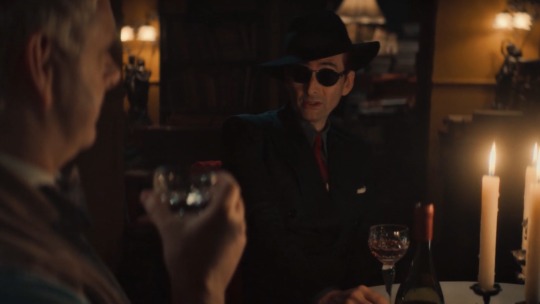
The night they met
The Blitz, short for Blitzkrieg (literally: flash war) was a German aerial bombing campaign on British cities in the WW2, spanning between 7 September 1940 and 10 May 1941. The Luftwaffe attacks were carried out almost non stop, with great intensity meant to force a capitulation and similarly strong impact on British life and culture at the time.
Starting on 7 September 1940, London as the capital city was bombed for nearly 60 consecutive nights. More than one million London houses were destroyed or damaged, and more than 20,000 civilians were killed, half of the total victims of this campaign.
The night of 29 December 1940 saw the most ferocity, becoming what is now known as the Second Great Fire of London. The opening shot of the S2 1941 minisode is a direct reference to recordings of that event, with the miraculously saved St Paul’s Cathedral in the upper left corner.
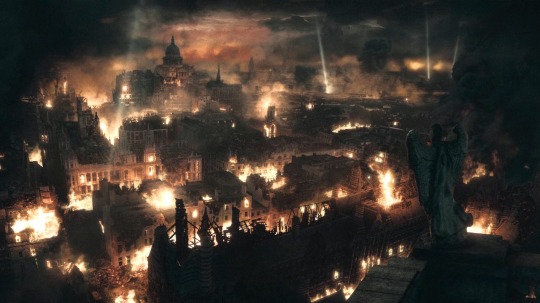
The actual raid lasted between 06:15 and 09:45 PM, but its aftermath continued for days. The old and dense architecture of this particular part of the city turned into a flaming inferno larger than the Great Fire of 1666. Multiple buildings, including churches, were destroyed in just one night by over 100,000 bombs.
Incendiary bombs fell also on St Dunstan-in-the-East church that night, the real-life location of this scene as intended by Neil. It was gutted and again claimed by fire in one of the last air rides on 10 May, when the bomb destroyed the nave and roof and blew out the stained glass windows. The ruins survived to this day as a memorial park to the Blitz.
Such a delightfully Crowley thing to do: saving a bag of books with a demonic miracle adding to the biggest catastrophe for the publishing and book trade in years. 5 million volumes were lost, multiple bookshops and publishing houses destroyed in the December 29th raid alone.
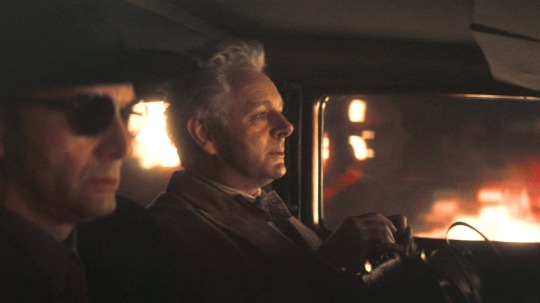
Even without this context, judging by the seemingly unending night, overwhelming cold and darkness, broken heating at the theatre, and seasonal clothing (like Aziraphale and Crowley’s extremely nice winter coats), it’s rather clear that it was the very beginning of the year 1941.
Everything suggests that Aziraphale and Crowley’s Blitz reunion happened exactly 1900 years after their meeting in Rome — which, according to the script book, took place between 1 and 24 January 41 (Crowley was right: emperor Caligula was a mad tyrant and didn't need any additional tempting; there's a reason why he was murdered by his closest advisors, including members of his Praetorian Guard, on 24 January 41).
Interestingly, both events involved a role reversal in their otherwise stable dynamic, with Aziraphale spontaneously taking the lead instead of letting the demon be the one to do all the tempting and saving, and ended with a toast.
The S2 Easter Egg with the nuns of the Chattering Order of St Beryl playing table tennis at the theatre suggests that the Blitz meeting happened on a Tuesday afternoon, which doesn’t match any of the above mentioned days, but sets the in-universe date for 7 January 1941 or later.
The Chattering Order of Saint Beryl is under a vow to emulate Saint Beryl at all times, except on Tuesday afternoons, for half an hour, when the nuns are permitted to shut up, and, if they wish, to play table tennis.

The nightingale
January means one thing: absolutely no migratory birds in Europe yet. They’re blissfully wintering in the warm sun of Northern Africa at the time. But, ironically, when the real nightingales flew off, a certain song about them suddenly gained popularity in the West End of London.
It might be a shock, but A Nightingale Sang in Berkeley Square wasn’t a hit from the start — even though its creators, Eric Maschwitz and Manning Sherwin, were certainly established in their work at this point. The song was written in the then-small French fishing village of Le Lavandou shortly before the outbreak of the Second World War with first performance in the summer of 1939 in a local bar, where the melody was played on piano by the composer Manning Sherwin with the help of the resident saxophonist. Maschwitz sang his lyrics while holding a glass of wine, but nobody seemed impressed. It took time and a small miracle to change that.
Next year, the 23-year-old actress Judy Campbell had planned to perform a monologue of Dorothy Parker’s in the upcoming Eric Maschwitz revue „New Faces”. But somehow the script had been mislaid and, much to her horror, replaced with the song A Nightingale Sang in Berkeley Square. She had never professed to be a singer but even so, she gathered her courage and went out onto the moonlit set dressed in a white ball gown. Her heartfelt rendition of the now evocative ballad captured the audience’s imagination and catapulted her West End career to stardom.
It was precisely 11 April 1940 at the Comedy Theatre in Panton Street and the revue itself proved to be a great success — not only it kept playing two performances nightly through the Blitz, but also returned the next year. And the still operating Comedy Theatre is mere five minutes on foot from the Windmill Theatre, where Aziraphale performed in 1941, and not much longer from his bookshop.
Now, most Good Omens meta analyses focus on Vera Lynn’s version of the song from 5 June 1940, but it didn’t get much attention until autumn, specifically 15 November, when Glenn Miller and his orchestra published another recording. And Glenn Miller himself is a huge point of reference in Good Omens 2.

According to the official commentary the infamous credits scene is establishing Aziraphale and Crowley’s final resolve for the next season using the same narrative device The Glenn Miller Story (1954) does in its most crucial scene. It starts with the tune (and audio in general) totally flat, then adds a piano on one side, and gradually becomes fully multidimensional. The Good Omens credits not only emulate the same sound effect, but bring it to the visual side of the narrative by literally combining the individual perspectives of the two characters together. Even though they’re physically apart, their resolve — and love to each other — brings them even closer than before. Aziraphale smiles not because he’s being brainwashed, but because he knows exactly what to do next.
Some of you might have noticed that Tori Amos’s performance for Good Omens is actually a slightly shortened version of Miller’s recording — much less sorrowful than Vera Lynn’s full lyrics that include i.a. this bridge:
The dawn came stealing up
All gold and blue
To interrupt our rendez-vous
I still remember how you smiled and said
Was that a dream or was it true?
Which is a huge hint when it comes to what we can expect from the main romantic plot line in the Good Omens series. The original song introduces an element of the doubt — it seems like there was no nightingale at all, only the mirage woven by the singer clearly intoxicated with love, much like Aziraphale and Crowley for the length of the last six episodes. Crowley’s comment in the season finale might allude to that interpretation, stating that there are no nightingales — never have been. It was all a dream. But the version we’re working with here is short and sweet, and devoid of that doubt. In the Good Omens universe angels were actually dining at the Ritz, the streets were truly paved with stars (or will be shown as such in the next season), and a nightingale really sang in Berkeley Square, as the omniscient, omnipresent, and omnipotent narrator, God Herself, had shown us.
All in all, it’s not an accident that the “modern” swing ballad activating Aziraphale’s memory and opening the 1941 minisode is the Moonlight Serenade by Glenn Miller. It’s a track naturally associated with A Nightingale Sang in Berkeley Square when it comes to music style and the sentiment in the lyrics.
But why the sudden popularity? In the great uncertainty and hardship of the Blitz, A Nightingale Sang in Berkeley Square provided solace and escapism for listeners, offering a glimpse of hope and love amidst the darkness of war. It became a universal anthem of resilience and a reminder of the power of love transcending difficulties. By January 1941 the whole city knew this tune by heart, including a certain West End aficionado with a cabinet full of theatre programs in his bookshop. Thanks to Maggie’s grandmother, he most probably had a record at hand to play during his spontaneous wine night with Crowley. We can only suspect the details, but it was was mutually established as their song exactly at that time or soon afterwards. Pretty sure we will see a third installment of that minisode for many, many reasons, but especially because of this “several days in 1941” answer by Neil:
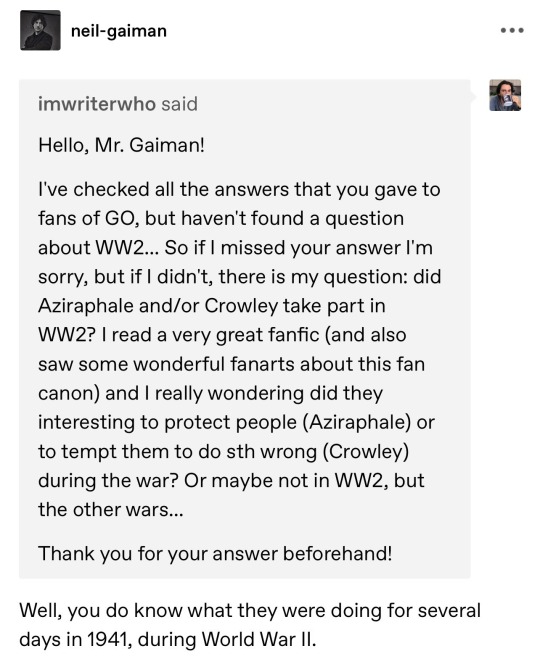
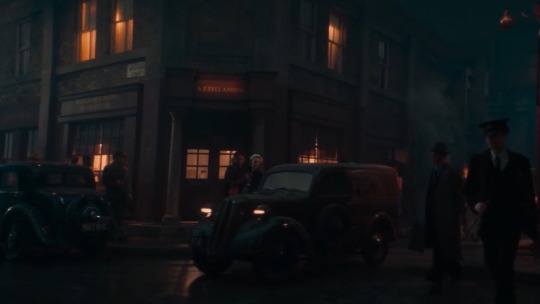
The Man Hunt
In 1941 A Nightingale Sang in Berkeley Square gained even more popularity as the romantic theme of the Fritz Lang’s newest film Man Hunt. The 1939 story by Geoffrey Household first appeared under the title “Rogue Male” as a serial in the Atlantic Monthly Magazine where it received widespread comment, soon becoming a world-wide phenomenon in novel form. Its premise criticizes Britain's pre-war policy of appeasement with Germany, ready to sacrifice its own innocent citizens to the tentative status quo. Sounds a bit like Heaven's politics, right?
Yes, I'm trying to make you watch old movies again — like all the other classics, Man Hunt (1941) is easily available on YouTube and other streaming websites.
The next part will include spoilers, so scroll down to the next picture if you prefer to avoid them.
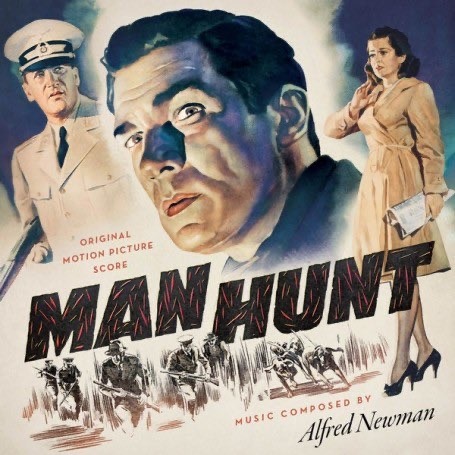
The plot of the movie seems simple enough: the tall, dark, and handsome Alan Thorndike, who nearly assassinates Hitler, narrowly escapes Germany and back in London continues to evade the Nazi agents sent after him with the help of a young trench-clad “seamstress” named Jerry, bridging the class divide and becoming unlikely friends-partners-romantic interests. It doesn’t end well though.
Jerry's small London apartment serves as a hideout for Alan when he was being followed by Nazis, similarly to how Aziraphale's bookshop is a safe haven for both Crowley and Gabriel in S2. She helps the man navigate the streets and eventually out of London — by sacrificing herself and getting forcefully separated from him by a patrolling policeman. The last time they see each other, Alan watches Jerry look back at him yearningly and disappear in the fog, followed by the elderly officer.
Unfortunately in the next scene we learn that the latter is a Nazi collaborator and helps the agents apprehend Jerry in her own flat. Staying loyal to her love and uncooperative, she’s ultimately thrown out of a window to her death, but posthumously saves Alan once again — through the arrow-shaped hatpin he gifted her earlier that is presented to him as the evidence of her off-screen fate.
Long story short, thanks to Jerry’s sacrifice Alan not only survives, but is able to join the war that broke out in the meantime and go back to Germany, armed with a rifle and a final resolve to end what he started, no matter how long will it take. The justice will be served and the dictator will pay with his life for his sins.
I wouldn’t be myself without mentioning that the main villain has a Roman chariot statue similar to the one in Aziraphale’s bookshop, an antique sculpture of St Sebastian (well-known as the gayest Catholic Saint) foreshadowing his demise, and a chess set symbolizing the titular manhunt/game of tag with the protagonist.
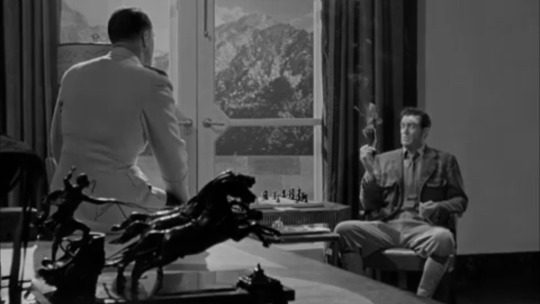
Aziraphale’s song
Will Aziraphale sacrifice himself as well? Or has he already? If his coin magic trick can be any indicator, we should expect at least a shadow of a danger touching the angel’s wings soon.
Let’s sum up the 1941 events from Aziraphale’s perspective: the very first time they’ve interacted after almost a century, Crowley actively sabotaged his entire existence twice by stepping onto a holy ground and by being outed by agents of Hell, both on the very same night and both because of his undying dedication to the angel. That’s enough of a reason not only for performing an apology dance, but also maintaining a careful distance for Crowley’s sake for the next 26 years. Only when he heard that his idiot was planning to rob a church, he gave up since he “can't have him risking his life”.
That’s when Crowley, sitting in a car parked right under his bookshop, offered him a ride. It wasn’t even subtle anymore. It was supposed to be a date, this time both of them understood it. But Aziraphale wouldn’t risk Crowley’s safety for his own happiness, especially not when he can name his feelings towards him and knows that they are reciprocated — the biggest lesson he learnt back in 1941.
So he did what he’s best at, he cut Crowley off again, but this time with a promise of catching up to his speed at some point. Buddy Holly’s Everyday, which was originally planned to play afterwards instead of the Good Omens theme, adds additional context here:
No, thank you. Oh, don’t look so disappointed. Perhaps one day we could... I don't know… Go for a picnic. Dine at the Ritz.
Aziraphale, carefully looking around and feeling observed through the whole conversation in the Bentley, consciously used the “Dine at the Ritz” line from A Nightingale Sang in Berkeley Square, from their song, as a code only the two of them understand. Not as a suggestion to go out for a meal, but a promise. A hope for the privilege of being openly in love and together — maybe someday, not now, when it’s too dangerous — even if it leads to a bad ending.
Fast forward to 2023 when for one dreadful moment Crowley’s “No nightingales” robbed Aziraphale even of that semblance of hope. He looked away, unable to stop his tears anymore. Only their kiss helped him pull himself together and make sure that a nightingale did sing the last time he turned — just like in their song — this time without a smile, as a goodbye.
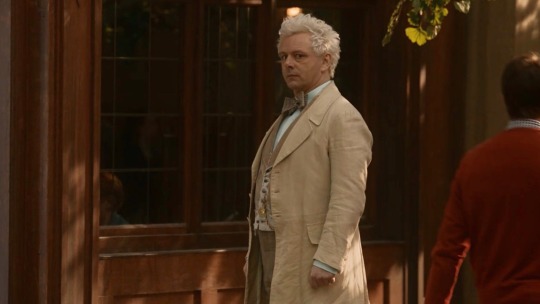
#a nightingale sang in the london blitz#the song is a code#and is miracled as a sign#aziraphale needs a hug#no nightingales#history rant#yuri is doing her thing#the good omens crew is unhinged#neil gaiman#st dunstan-in-the-east#1941 minisode#1941 flashback#a nightingale sang in berkeley square#good omens#good omens meta#good omens 2#go2 meta#go2#ineffable husbands#aziraphale#crowley#1941 aziraphale#1941 crowley#the blitz#man hunt (1941)#the glenn miller’s story (1954)#why am i like this#why do i do this to myself#long post
314 notes
·
View notes
Text
An open letter to bigfatbimbo.🪽
Reasons why you should write for Adam.

1 -> He is a misogynist (not for long)

Look at his face. He is so weird. I swear. He has been favoritized for far too long, leaving him with the most mind-numbing god complex. Don't you want to stab him to death like niffty? Don't you want to put him where he deserves to be (either underground or under me)? I do. You should too! Because his way of thinking meets it's end where my heels begin.
2 -> He is stupid

He has the emotional maturity of a boiled lobster. He fits into heaven like an orca in the amazon river. He is so unbelievably incompetent it is actually kind of mind boggling. Don't you want to crush him like he's a little bug (either with your fists or your thighs)? Didn't he literally say one of the "biggest issues evet" was math or something? He probably couldn't tell you where Africa is in the world map even if you paid him. Even the fruit of knowledge couldn't give him enough braincells to function as a proper member of society.
3 -> he deserves humiliation
He deserves to have his entire worldview rocked and destroyed, something we can surely provide. His shallow thinking should be promptly obliterated. He has only ever gotten away from beautiful tall strong women because he always had the option of just asking for a different woman. They didn't have the mental fortitude to put him in his place. We are the bearers of the curse (liking repulsive men), and, since there is no "mental fortitude" to begin with, there is nothing for him to break down. We (as a collective) should end him.

4 -> I know what he is
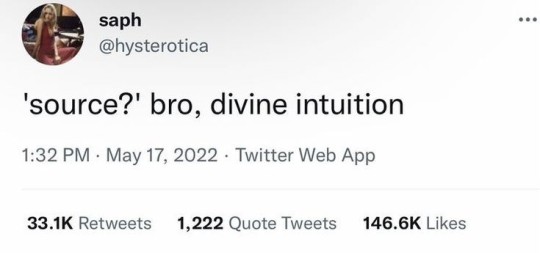
His entire persona is a gigantic act to make up for the fact he cannot appropriatelly cope with losing in general, much less losing the, like, 2 wives he ever had (to THE SAME GUY!! MIND YOU!!!) and if he had more people they were one night stands. Not because he left them, but because people know he is worthless scum and he is good for nothing other than his "original dick" ( eugh. I usually refrain from cursing >:// ). It is the reason for his pride and also the only thing that makes him even remotely worth the hastle of talking to. He is the equivalent of a carnival prize to the people in heaven, scoring him is more of a show of your own endurance rather than how coveted he is. He has been objectified through his own hubris. He should be made aware of that. He should fear the knowledge we posses. It should be used against him.
5 -> he sounds.. like.. . He sounds good.
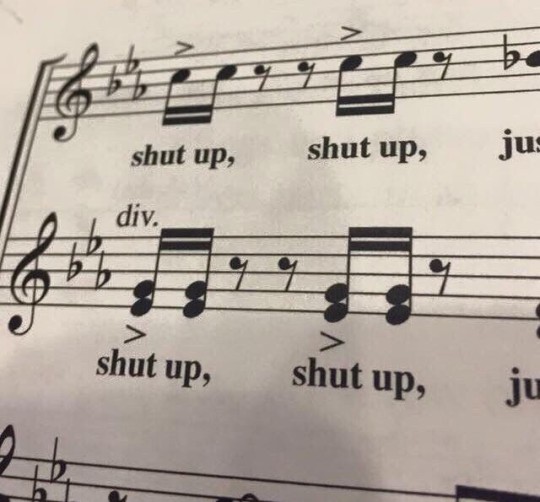
I watched the series while skipping most of the songs but I genuinelly could not do it when he was singing. No wonder he's in a band or something, I didn't actually pay attention to what he was saying I was paying more attention to the sound of his voice so I don't remember clearly what's up with that. Like he sounds REALLY good. If only he knew how to just use his voice without saying the most repulsive atrocities to be ever uttered by anyone ever. Oh yeah! We can make him incoherent enough for that to happen.
6 -> Lute deserves better

Lute deserves, like, a woman. Not him. She's too gorgeous for him, and, the difference between us and her is that while SHE is dealing with HIM, in our case, HE has to deal with US. Really, we're just saving a beautiful, amazing, stunning, showstopping woman a lot of trouble, and getting an ENTIRE PATHETIC MAN AS A TRADE! WIN WIN! Literally no downsides, I swear.
7 -> he is girl dinner

Don't you just love looking into your fridge and seeing the worthless scraps that built up overtime but somehow taste better now than they usually would have, which is particularly shocking considering it has 0 nutritional value? That would be what girl dinner is, and also an appropriate analogy for what Adam is like! Just roughly ok looking enough for you to not downright call it a biohazard. You will go to bed satisfied after fighting tooth and nail for your dinner (getting him to behave properly) and, it'll be easier the next times maybe! Operant conditioning is a heavy hitter with this repulsive individual, so it might actually get easier! Who knows!
8 -> Pretty please? (´。・д人)゙

I really. Uh . I really want him if you couldn't tell? Maybe the cannibalism and the fear I want to instill into him got in the way of you seeing my point, but, like, that's just how I love. The highest honor I could bestow on him is wanting to eat him, so, maybe that'll assist in your judgement? I also just really like your writing and would love to hear your thoughts on his idiotic self. AND! AND! Other people also want you to write about him if I well remember the 1 ask you received about him!

I await your response when you are available @bigfatbimbo
If you need more convincing; I can, like, draw him? I'm going to draw him no matter what but like I can cook something up for you in particular who knows.
You did say you were already considering writing for him, so, maybe this can be a final push in that direction for you!
- sincerely, Bow
#hazbin hotel x reader#hazbin hotel adam#hazbin hotel#hazbin hotel adam x reader#he is the worst#I want him reaaalll bad#if anyone also sees this letter and is convinced by my arguments#I absolutely insist that you @ me in whatever you chose to make#I would be honored
264 notes
·
View notes
Text
European history is not white


Someone commented this to a post I reblogged, which message is basically "we shouldn't venerate the Dead White Man HistoryTM and we should elevate other history too, but we still need to learn Dead White Man HistoryTM to understand the world today". It's basically a response to the attitude you sometimes come across in the internet that sees learning about those Dead White MenTM as not worth our time. And this person, who seems to be following this blog because they responded to my reblog, takes it as a personal attack against all white Europeans. For some reason. Well I take these comments as a personal attack against historical understanding.
Firstly, the post clearly didn't say you shouldn't venerate any European history, because not all European history is Dead White Man HistoryTM. Obviously this person thinks European history is white, which is not true, but surely, surely, they know it's not all men? Secondly, what is "west culture"? When did it start? There is not one western culture, not one European culture. The first concept of some shared Europeanness was the Christendom in Middle Ages, but it was not exactly the same as we think of Europe today, because it did not include the pagan areas, but it included a lot of Levant and parts of Central Asia, where there were large Christian areas. And Europe was not "very white" nor was the Christendom. The more modern concept of West was cooked in tandem with race and whiteness during colonial era and Enlightenment, around 17th to 18th centuries. And Europe was certainly not very white then. The western world also includes a lot of colonized areas, so that's obviously not white history. Thirdly, implying that asking white people to apologize for European history (which no one did ask) is as ridiculous as asking black people for African history is... a choice. Black people do exist in a lot of other places than Africa, which white people should be the ones apologizing for, and really white people also have a lot to answer for about African history. Lastly, if you think the quote "anyone who thinks those dead white guys are aspirational is a white supremacist" means you as an European are demanded to apologize for your existence, maybe - as we say in Finland - that dog yelps, which the stick clanks. (I'm sorry I think I'm the funniest person in the world when I poorly translate Finnish sayings into English.)
The thing is, there is no point in European history, when Europe was white, for three reasons. 1) Whiteness was invented in 17th century and is an arbitrary concept that has changed it's meaning through time. 2) Whichever standard you use, historical or current, Europe still has never been all or overwhelmingly white, because whiteness is defined as the in-group of colonialists, and there has always been the internal Other too. In fact the racial hierarchy requires an internal Other. 3) People have always moved around a lot. The Eurasian steppe and the Mediterranean Sea have always been very important routes of migration and trade. I've been meaning to make a post proving exactly that to people like this, since as I've gathered my collection of primary images of clothing, I've also gathered quite a lot of European primary images showing non-white people, so I will use this opportunity to write that post.
So let's start from the beginning. Were the original inhabitants of Europe white? Of course not. The original humans had dark skin so obviously first Europeans had dark skin. Whenever new DNA evidence of dark skinned early Europeans come out (like this study), the inevitable right-wing backlash that follows is so interesting to me. Like what did you think? Do you still believe the racist 17th century theories that white people and people of colour are literally different species? I'm sure these people will implode when they learn that studies (e.g. this) suggest in fact only 10 000 years ago Europeans had dark skin, and even just 5 000 years ago, when Egypt (an many others) was already doing it's civilization thing, Europeans had brown skin (another source). According to the widely accepted theory, around that time 5 000 years ago the Proto-Indo-European language developed in the Pontic-Caspian steppe, which extends from Eastern Europe to Central Asia. These Proto-Indo-Europeans first migrated to Anatolia and then to Europe and Asia. Were they white? Well, they were probably not light skinned (probably had brown skin like the other people living in Europe around that time), the Asian branch of Indo-European peoples (Persians, most Afghans, Bengalis, most Indians, etc.) are certainly not considered white today and a lot of the people today living in that area are Turkic and Mongolic people, who are also not considered white. I think this highlights how nonsensical the concept of race is, but I don't think Proto-Indo-Europeans would have been considered white with any standard.
Around Bronze Age light skin became common among the people in Europe, while in East Asia it had become wide spread earlier. This does not however mark the point when "Europe became white". During the Bronze Age there was a lot of migration back and forth in the Eurasian steppe, and the early civilizations around Mediterranean did a lot of trade between Europe, Africa and Asia, which always means also people settling in different places to establish trading posts and intermarrying. There were several imperial powers that also stretched to multiple continents, like the briefly lived Macedonian Empire that stretched from Greece to Himalayas and Phoenicians from Levant, who didn't built an empire but settled in North Africa, Sicily and Iberia. In Iron Age the Carthaginian Empire, descendants of Phoenician settlers in current Tunisia, build an Empire that spanned most of the western Mediterranean coast. Their army occupying that area included among others Italic people, Gauls, Britons, Greeks and Amazigh people.
Iron Age also of course saw the rise of the Roman Republic, and later empire, but it was preceded by Etruscans, who populated Tuscan, and possibly preceded the Indo-European presence. However, weather through trade and migration with other Mediterraneans or the continuing presence of darker skin tones of the early Europeans, their art quite often depicts darker skin tones too, like seen below in first two images. Roman Empire at it's height spanned from Babylonia to the British Isles. They recruited soldiers from all provinces and intentionally used stationed them in different areas so they wouldn't be too sympathetic to possible rebels or neighboring enemies. Historical sources mention black Nubian soldiers in British Isles for example. They also built a lot of infrastructure around the empire to ensure protection and easy transportation through trade routes inside the empire. During this time Jewish groups also migrated from Levant to both North-Africa and Europe. Rome even had non-European emperors, like Septimius Severus who originated from Levant and was Punic (descendants of Phoenicians) from his father's side, and who was depicted with darker skin (third picture below). Various ethnicities with differing skin tones are represented all over Roman art, like in the fourth picture below from hunting lodge in Sicily.

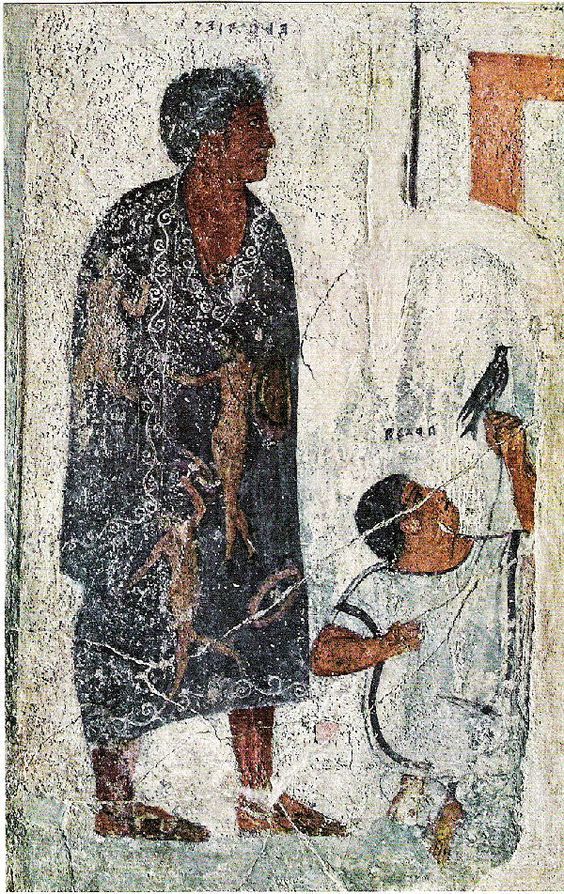


Eurasian steppe continued to be important source of migration and trade between Europe and Asia. Scythians, Iranic nomadic people, were important for facilitating the trade between East Asia and Europe through the silk road during the Iron Age. They controlled large parts of Eastern Europe ruling over Slavic people and later assimilating to the various Slavic groups after loosing their political standing. Other Iranic steppe nomads, connected to Scythian culture also populated the Eurasian steppe during and after Scythia. During the Migration Period, which happened around and after the time of Western Rome, even more different groups migrated to Europe through the steppe. Huns arrived from east to the Volga region by mid-4th century, and they likely came from the eastern parts of the steppe from Mongolian area. Their origins are unclear and they were either Mongolic, Turkic or Iranic origin, possibly some mix of them. Primary descriptions of them suggests facial features common in East Asia. They were possibly the nomadic steppe people known as Xiongnu in China, which was significant in East and Central Asia from 3rd century BCE to 2nd century CE until they moved towards west. Between 4th and 6th centuries they dominated Eastern and Central Europe and raided Roman Empire contributing to the fall of Western Rome.
After disintegration of the Hun Empire, the Huns assimilated likely to the Turkic arrivals of the second wave of the Migration Period. Turkic people originate likely in southern Siberia and in later Migration period they controlled much of the Eurasian steppe and migrated to Eastern Europe too. A Turkic Avar Khagenate (nation led by a khan) controlled much of Eastern Europe from 6th to 8th century until they were assimilated to the conquering Franks and Bulgars (another Turkic people). The Bulgars established the Bulgarian Empire, which lasted from 7th to 11th in the Balkans. The Bulgars eventually adopted the language and culture of the local Southern Slavic people. The second wave of Migration Period also saw the Moor conquest of Iberia and Sicily. Moors were not a single ethnic group but Arab and various Amazigh Muslims. Their presence in the Iberian peninsula lasted from 8th to 15th century and they controlled Sicily from 9th to 11th century until the Norman conquest. During the Norman rule though, the various religious and ethnic groups (which also included Greeks and Italic people) continued to live in relative harmony and the North-African Muslim presence continued till 13th century. Let's be clear that the Northern Europe was also not white. Vikings also got their hands into the second wave migration action and traveled widely to east and west. Viking crews were not exclusively Scandinavians, but recruited along their travels various other people, as DNA evidence proves. They also traded with Byzantium (when they weren't raiding it) and Turkic people, intermarried and bought slaves, some of which were not white or European. A Muslim traveler even wrote one of the most important accounts of Vikings when encountering them in Volga.
By this point it should already be clear that Medieval Europe was neither white, but there's more. Romani people, who originate from India and speak Indo-Aryan language, arrived around 12th century to Balkans. They continued to migrate through Europe, by 14th century they were in Italy, by 15th century in Germany and by 16h century in Britain and Sweden. Another wave of Romani migration from Persia through North-Africa, arrived in Europe around 15th century. Then there's the Mongol Empire. In 13th century they ruled very briefly a massive portion of the whole Eurasian continent, including the Eastern Europe. After reaching it's largest extent, it quickly disintegrated. The Eurasian Steppe became the Golden Horde, but lost most of the Eastern-Europe, except Pontic-Caspian Steppe. They ruled over Slavs, Circissians, Turkic groups and Finno-Ugric groups till early 15th century. The Mongolian rulers assimilated to the Turkic people, who had been the previous rulers in most of the steppe. These Turkic people of the Golden Horde came to be known as Tatars. Golden Horde eventually split into several Tatar khagenates in 15th century, when the khagenates, except the Crimean Khagenate, were conquered by the Tsardom of Moscovy. Crimean Khagenate was annexed by the Russian Empire in 1783. Crusades were a movement from Europe to Levant, but they also meant intermarriage in the the Crusader kingdoms especially between the European and Levant Christians, and some movement back and froth between these kingdoms and Europe, trade and a lot of movement back after the Crusader kingdoms were defeated in 13th century. Generally too trade across the Mediterranean sea was extensive and led to migration and intermarriage.
And here's some example of people of colour in Medieval European art, shown as part of the majority white European societies. First is from a 15th century French manuscript depicting Burgundy court with dark skin courtier and lady in waiting. Second one is from a Flemish manuscript from 15th century of courtiers, including a black courtier, going for a hunt. Third is a 15th century Venetian gondolier with dark skin.

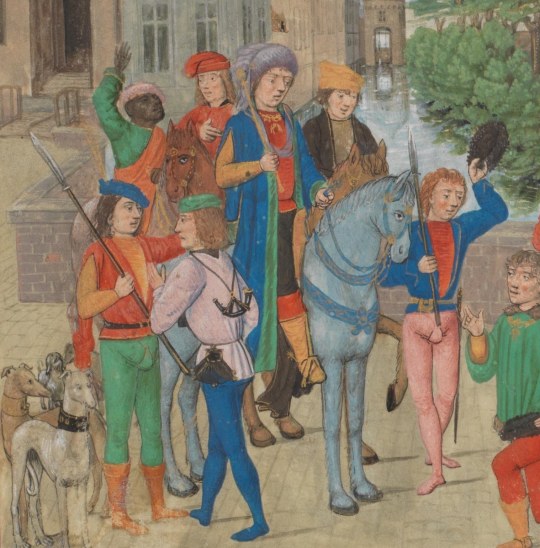

In Renaissance Era Europe was only increasing it's trade and therefore had even more connections outside Europe. The first picture below is Lisbon, which had strong trade relationship with Africa, depicted in late 16th century. People with darker skin tones were part all classes. Second image is an Italian portrait of probably a seamstress from 16th century. Third one is a portrait of one of the personal guards of the Holy Roman Emperor. Fourth image is a portrait of Alessandro de' Medici, duke of Florence, who was noted for his brown complexion, and the modern scholarly theory is that his mother was a (likely brown) Italian peasant woman.
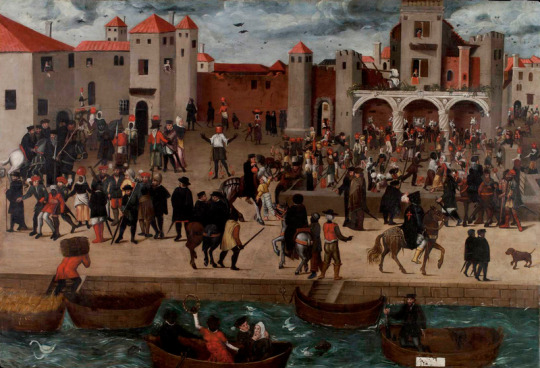

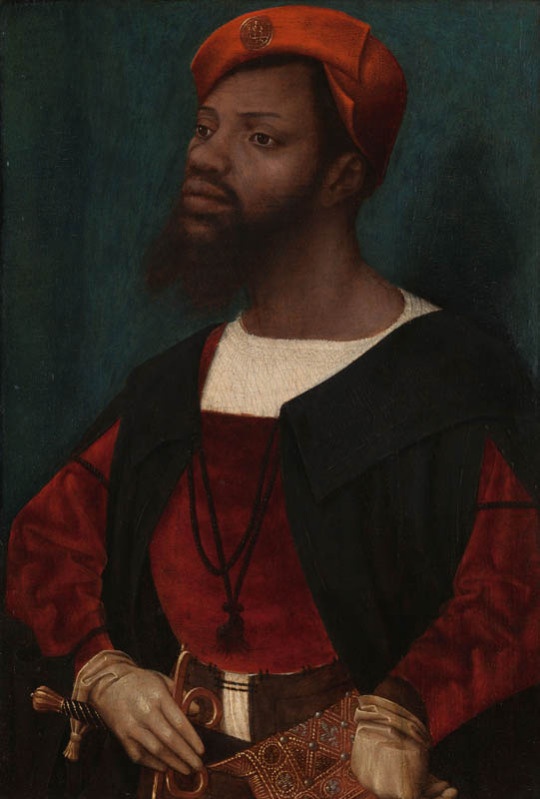

Colonialism begun in the Renaissance Era, but the wide spread colonial extraction and slavery really got going in the 17th century. Racial hierarchy was developed initially to justify the trans-Atlantic slave trade specifically. That's why the early racial essentialism was mostly focused on establishing differences between white Europeans and black Africans. Whiteness was the default, many theories believed humans were originally white and non-whites "degenerated" either through their lives (some believed dark skin was basically a tan or a desease and that everyone was born white) or through history. Originally white people included West-Asians, some Central-Asians, some North-Africans and even sometimes Indigenous Americans in addition to Europeans. The category of white inevitably shrank as more justifications for atrocities of the ever expanding colonial exploitation were required. The colonial exploitation facilitated development of capitalism and the industrial revolution, which led to extreme class inequality and worsening poverty in the European colonial powers. This eventually became an issue for the beneficiaries of colonialism as worker movements and socialism were suddenly very appealing to the working class.
So what did the ruling classes do? Shrink whiteness and give white working classes and middle classes justifications to oppress others. Jews and Roma people had long been common scapegoats and targets of oppression. Their oppression was updated to the modern era and racial categories were built for that purpose. The colonial powers had practiced in their own neighborhoods before starting their colonial projects in earnest and many of those European proto-colonies were developed to the modern colonial model and justified the same way. In 19th century, when racial pseudoscience was reaching it's peak, Slavs, others in Balkan, the Irish (more broadly Celts), Sámi (who had lost their white card very early), Finns, Southern Italians, the Spanish, the Southern French and Greeks all were considered at least not fully white. The Southern Europeans and many Slavs were not even colonized (at least in the modern sense, though with some cases like Greeks it's more complicated than that), but they looked too much and were culturally too similar to other non-white Mediterraneans, and they were generally quite poor. In many of these cases, like Italians, the French and Slavs, it was primarily others belonging in the same group, who were making them into second class citizens. All this is to highlight how very malleable the concept of race is and that it's not at all easy to define the race of historical people.
However, even if we would go with the racial categories of today, Europe was still far from being all white in this period. You had Roma, who certainly are not included in whiteness today, and European Jews, whose whiteness is very conditional, descendants of Moors in Southern Europe and Tatars and Turks in Eastern Europe and Turkey, which today is often not thought of as part of Europe, but historically certainly was. And then colonialism brought even more people into Europe forcibly, in search of work because their home was destroyed or for diplomatic and business reasons. There were then even more people of colour, but they were more segregated from the white society. Black slaves and servants are very much represented in European art from 17th century onward, but these were not the only roles non-white people in Europe were in, which I will use these examples to show. First is a Flemish portrait of Congo's Emissary, Dom Miguel de Castro, 1643. Second is a 1650 portrait of a Moorish Spanish man Juan de Pareja, who was enslaved by the artist as artisanal assistant, but was freed and became a successful artist himself. Third is a 1768 portrait of Ignatius Sancho, a British-African writer and abolitionist, who had escaped slavery as a 20-year-old. Fourth painting is from 1778 of Dido Elizabeth Belle, a British gentlewoman born to a slave mother who was recognized as a legitimate daughter by her father, and her cousin. The fifth portrait is of an unknown woman by (probably) a Swiss painter from late 18th century. Sixth is a 1760s Italian portrait of a young black man.

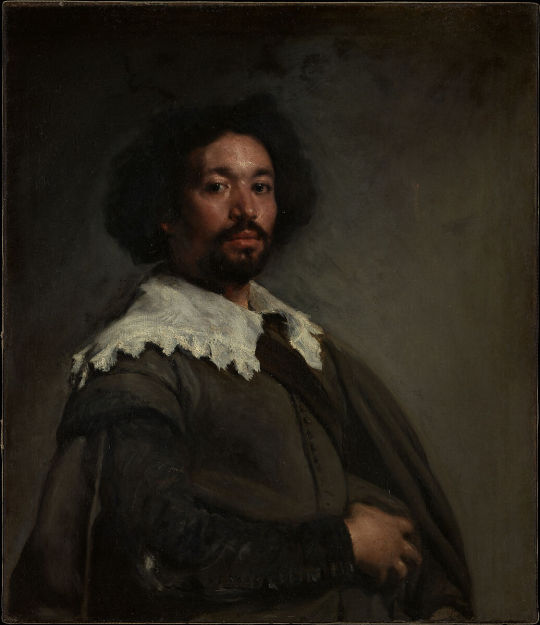
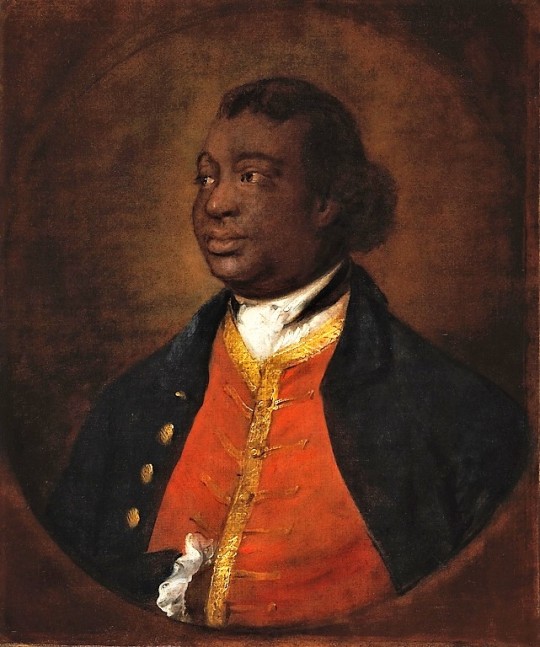
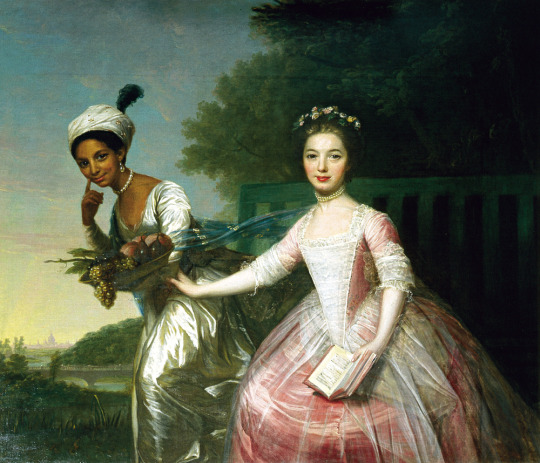
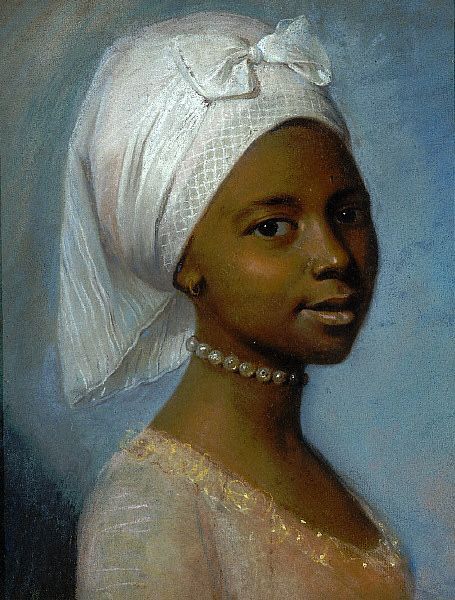
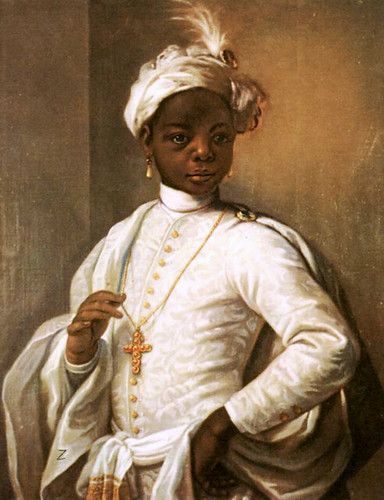
In late 18th century England abolished slavery in British Isles first, then in early 19th century in the whole British Empire, thanks to the continuous campaign of free Black people and some white allies, notably Quakers. Around the same time slavery was abolished in France (briefly till Napoleon got to power) after the French revolution. This meant there were a lot more free black people in Europe after that. In 18th century the Europeans, British especially, were colonizing Asia as much they could, which meant that in 19th century there started to also be a lot more Asian, especially Indian people in Europe. First picture below is of Thomas Alexander Dumas, who was son of a black slave woman and a white noble French man and became a general in the French revolutionary army. His son was one of the most well-known French authors, Alexander Dumas, who wrote The Count of Monte Cristo and The Three Musketeers. Second portrait is of Jean-Baptiste Belley, a Senegalese former slave, who became French revolutionary politician. Third portrait is from 1810 of Dean Mahomed, an Indian-British entrepreneur, who established the first Indian restaurant in London. Forth is Arab-Javanese Romantic painter Saleh Syarif Bustaman, who spend years in Europe. Fifth is a 1862 photo of Sara Forbes Bonnetta, originally named Aina, princess of Edbago clan of Yoruba, who was captured into slavery as a child, but later freed and made Queen Victoria's ward and goddaughter. She married a Nigerian businessman, naval officer and statesman, James Pinson Labulo Davies (sixth picture).
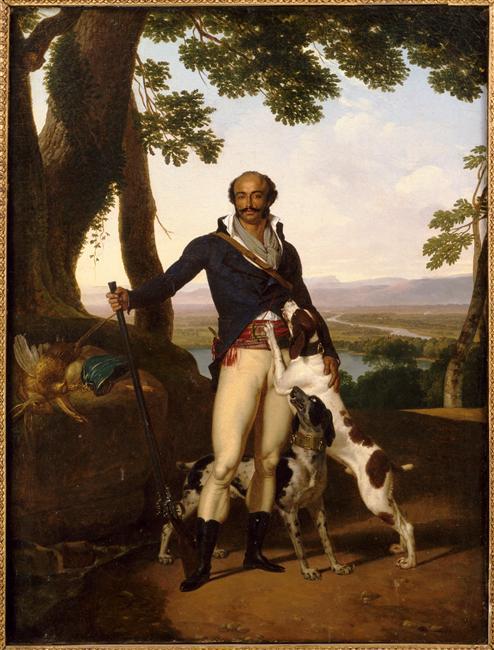


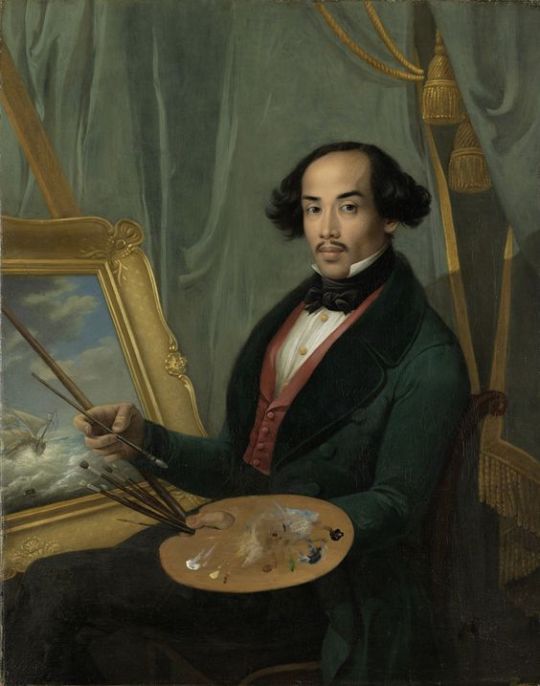
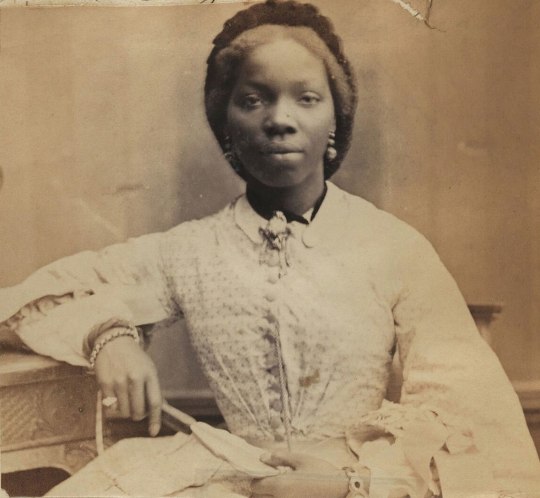
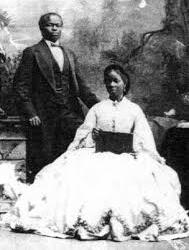
So any guesses on at what point was that "very white Europe" when the "west culture" begun? It kinda seems to me that it never actually existed.
#history#poc history#black history#historical art#european history#history of race#colonialism#racism#slavery#painting#photograph
175 notes
·
View notes
Note
I know you don't usually do these kinds of posts, but you're probably one of the most implicated in black history month people that I follow so I wanted to ask you, as I already value your opinions in Acotar, what do you think of the documentary where actual historians claim Cleopatra was a black woman? Lately, this has been a pretty active topic on my fyp on TikTok, and I wanted to know a black woman's perspective on this.
Thank you in advance, and if you usually don't answer these questions or don't want to answer this one, I'll totally understand, and there's no problem at all.
I didn’t know there was a new documentary out, but when I saw the name Cleopatra I automatically sighed because I knew what was coming. This is a subject a know a little 🤏🏾 about, actually, because I researched it a bit myself in my last year of high school (and stopped because of the uh. NASTINESS associated with this particular subject) and though it’s been a few years I remembered some main, basic things, and I wanted to check a few things first.
At best, in the most CHARITABLE interpretation as far as I in my limited knowledge can tell, it would be correct to say that’s it’s POSSIBLE that she MAY have been mixed Black because, though she was part of the GREEK Ptolemaic dynasty that ruled Egypt (Ptolemy being one of Alexander the Great’s generals who got the Egyptian portion of his empire after Alexander died), that’s on her fathers side; her mother’s exact ethnicity isn’t known. Not that this won’t stop the hoteps from running off and claiming her and all of ancient Egypt as Black though So some have ***speculated*** that her mother—and thus Cleopatra—may have potentially been part Egyptian (and that goes into the issue of deciding that the “Egyptian” in this instance had to have been Black rather than MENA but that’s again a whole other can of worms). BUT it’s more likely that her mother was Greek due to the uh, PRACTICE™️ of inbreeding and it not being common for the dynasty to marry Egyptians. So it’s more probable that she was fully Greek/Macedonian and not part Egyptian, much less part Black. (Also some historians speculate she may have had Persian blood? I guess? Again it’s a can of worms, not something i’m digging deep into because of the nastiness that you often stumble across) Unless there’s a new study confirming her mother’s identity or something that I missed, it’s simply incorrect to claim that Cleopatra was undeniably Black, because though it is ***possible*** she most likely ***wasn’t.***
But this topic really upsets me, because there are LEGITIMATE Black kingdoms and empires who were mighty and well developed and powerful like the Aksumite empire and kingdoms of Kongo and Loango and the Great Zimbabwe empire and the empires of Ghana and Mali and Songhay and the Ashanti kingdom and the WHOLE SWAHILI COAST THAT WAS INVOLVED IN THE INDIAN OCEAN TRADE ROUTE and they had their own great rulers, their own kings and queens and emperors and empresses, their palaces and castles, their own cities and towns, their own complex civilizations and dynastic royal families that deserve the attention Cleopatra and ancient Egypt get. They were erased—and Egypt was not—by white people to prop themselves up as the only race capable of forming civilizations and advanced societies as a means of justifying colonization and imperialism to “civilize” the rest of the world and as a result many of those other empires have been erased from our education system here in the states and many people cling to ancient Egypt as proof that we’re not inferior and aren’t savages like white people claim due to believing that since Egypt’s in Africa it had to have been mostly Black when Egypt, and the Ptolemaic dynasty and Cleopatra in PARTICULAR, are literally the worst example that could’ve been chosen and were the only African kingdom spared erasure FOR A REASON.
Anyway, I don’t like it, it’s disingenuous and does US wrong because we need to give that energy to other African kingdoms that need and could use the fame Egypt + Cleopatra get, and we deserve a better education system to teach us this stuff. I hope this answers your question? And I don’t mind any kinds of asks 🥰
#I get the desire to claim Egypt because I remember in high school a racist white guy asked why Africans didn’t build their own civilizations#And that’s what sent me researching in the first place so I truly get the frustration but black women we can do BETTER#ask#anon#cleopatra#egypt#africa#racism#Don’t come at me in my inbox yall#antiblackness
1K notes
·
View notes
Text
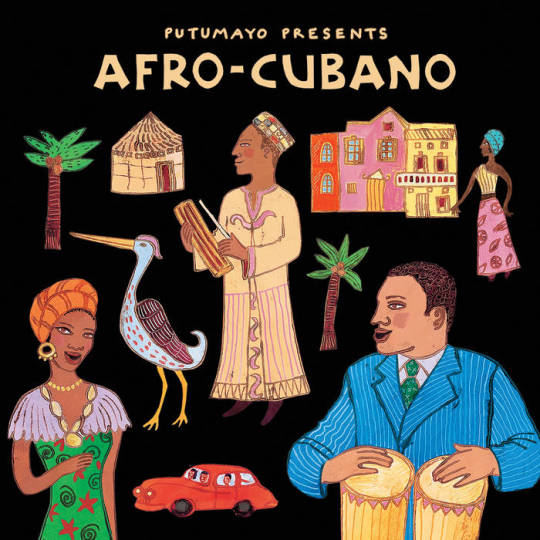
Music of African heritage in Cuba derives from the musical traditions of the many ethnic groups from different parts of West and Central Africa that were brought to Cuba as slaves between the 16th and 19th centuries. Members of some of these groups formed their own ethnic associations or cabildos, in which cultural traditions were conserved, including musical ones. Music of African heritage, along with considerable Iberian (Spanish) musical elements, forms the fulcrum of Cuban music.
Much of this music is associated with traditional African religion – Lucumi, Palo, and others – and preserves the languages formerly used in the African homelands. The music is passed on by oral tradition and is often performed in private gatherings difficult for outsiders to access. Lacking melodic instruments, the music instead features polyrhythmic percussion, voice (call-and-response), and dance. As with other musically renowned New World nations such as the United States, Brazil and Jamaica, Cuban music represents a profound African musical heritage.

Clearly, the origin of African groups in Cuba is due to the island's long history of slavery. Compared to the USA, slavery started in Cuba much earlier and continued for decades afterwards. Cuba was the last country in the Americas to abolish the importation of slaves, and the second last to free the slaves. In 1807 the British Parliament outlawed slavery, and from then on the British Navy acted to intercept Portuguese and Spanish slave ships. By 1860 the trade with Cuba was almost extinguished; the last slave ship to Cuba was in 1873. The abolition of slavery was announced by the Spanish Crown in 1880, and put into effect in 1886. Two years later, Brazil abolished slavery.
Although the exact number of slaves from each African culture will never be known, most came from one of these groups, which are listed in rough order of their cultural impact in Cuba:
The Congolese from the Congo Basin and SW Africa. Many ethnic groups were involved, all called Congos in Cuba. Their religion is called Palo. Probably the most numerous group, with a huge influence on Cuban music.
The Oyó or Yoruba from modern Nigeria, known in Cuba as Lucumí. Their religion is known as Regla de Ocha (roughly, 'the way of the spirits') and its syncretic version is known as Santería. Culturally of great significance.
The Kalabars from the Southeastern part of Nigeria and also in some part of Cameroon, whom were taken from the Bight of Biafra. These sub Igbo and Ijaw groups are known in Cuba as Carabali,and their religious organization as Abakuá. The street name for them in Cuba was Ñáñigos.
The Dahomey, from Benin. They were the Fon, known as Arará in Cuba. The Dahomeys were a powerful group who practised human sacrifice and slavery long before Europeans arrived, and allegedly even more so during the Atlantic slave trade.
Haiti immigrants to Cuba arrived at various times up to the present day. Leaving aside the French, who also came, the Africans from Haiti were a mixture of groups who usually spoke creolized French: and religion was known as vodú.
From part of modern Liberia and Côte d'Ivoire came the Gangá.
Senegambian people (Senegal, the Gambia), but including many brought from Sudan by the Arab slavers, were known by a catch-all word: Mandinga. The famous musical phrase Kikiribu Mandinga! refers to them.
Subsequent organization
The roots of most Afro-Cuban musical forms lie in the cabildos, self-organized social clubs for the African slaves, and separate cabildos for separate cultures. The cabildos were formed mainly from four groups: the Yoruba (the Lucumi in Cuba); the Congolese (Palo in Cuba); Dahomey (the Fon or Arará). Other cultures were undoubtedly present, more even than listed above, but in smaller numbers, and they did not leave such a distinctive presence.
Cabildos preserved African cultural traditions, even after the abolition of slavery in 1886. At the same time, African religions were transmitted from generation to generation throughout Cuba, Haiti, other islands and Brazil. These religions, which had a similar but not identical structure, were known as Lucumi or Regla de Ocha if they derived from the Yoruba, Palo from Central Africa, Vodú from Haiti, and so on. The term Santería was first introduced to account for the way African spirits were joined to Catholic saints, especially by people who were both baptized and initiated, and so were genuine members of both groups. Outsiders picked up the word and have tended to use it somewhat indiscriminately. It has become a kind of catch-all word, rather like salsa in music.
The ñáñigos in Cuba or Carabali in their secret Abakuá societies, were one of the most terrifying groups; even other blacks were afraid of them:
Girl, don't tell me about the ñáñigos! They were bad. The carabali was evil down to his guts. And the ñáñigos from back in the day when I was a chick, weren't like the ones today... they kept their secret, like in Africa.
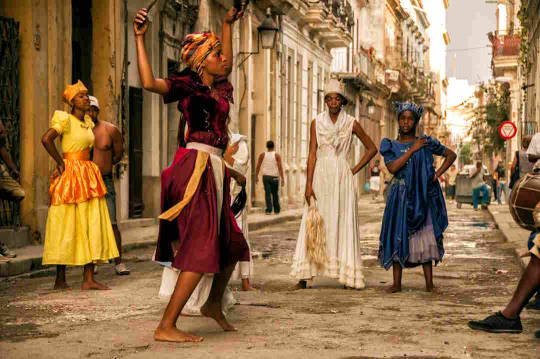
African sacred music in Cuba
All these African cultures had musical traditions, which survive erratically to the present day, not always in detail, but in the general style. The best preserved are the African polytheistic religions, where, in Cuba at least, the instruments, the language, the chants, the dances and their interpretations are quite well preserved. In few or no other American countries are the religious ceremonies conducted in the old language(s) of Africa, as they are at least in Lucumí ceremonies, though of course, back in Africa the language has moved on. What unifies all genuine forms of African music is the unity of polyrhythmic percussion, voice (call-and-response) and dance in well-defined social settings, and the absence of melodic instruments of an Arabic or European kind.
Not until after the Second World War do we find detailed printed descriptions or recordings of African sacred music in Cuba. Inside the cults, music, song, dance and ceremony were (and still are) learnt by heart by means of demonstration, including such ceremonial procedures conducted in an African language. The experiences were private to the initiated, until the work of the ethnologist Fernando Ortíz, who devoted a large part of his life to investigating the influence of African culture in Cuba. The first detailed transcription of percussion, song and chants are to be found in his great works.
There are now many recordings offering a selection of pieces in praise of, or prayers to, the orishas. Much of the ceremonial procedures are still hidden from the eyes of outsiders, though some descriptions in words exist.
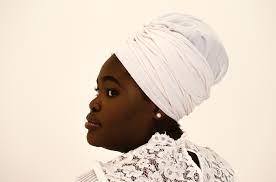
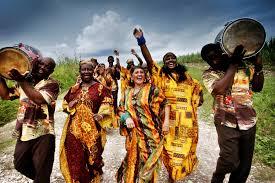
Yoruba and Congolese rituals
Main articles: Yoruba people, Lucumi religion, Kongo people, Palo (religion), and Batá
Religious traditions of African origin have survived in Cuba, and are the basis of ritual music, song and dance quite distinct from the secular music and dance. The religion of Yoruban origin is known as Lucumí or Regla de Ocha; the religion of Congolese origin is known as Palo, as in palos del monte.[11] There are also, in the Oriente region, forms of Haitian ritual together with its own instruments and music.
In Lucumi ceremonies, consecrated batá drums are played at ceremonies, and gourd ensembles called abwe. In the 1950s, a collection of Havana-area batá drummers called Santero helped bring Lucumí styles into mainstream Cuban music, while artists like Mezcla, with the lucumí singer Lázaro Ros, melded the style with other forms, including zouk.
The Congo cabildo uses yuka drums, as well as gallos (a form of song contest), makuta and mani dances. The latter is related to the Brazilian martial dance capoeira

#african#afrakan#kemetic dreams#africans#brownskin#brown skin#afrakans#african culture#fitness#afrakan spirituality#afro cuban music#afro cuban#igbo#yoruba#congo#african music
151 notes
·
View notes